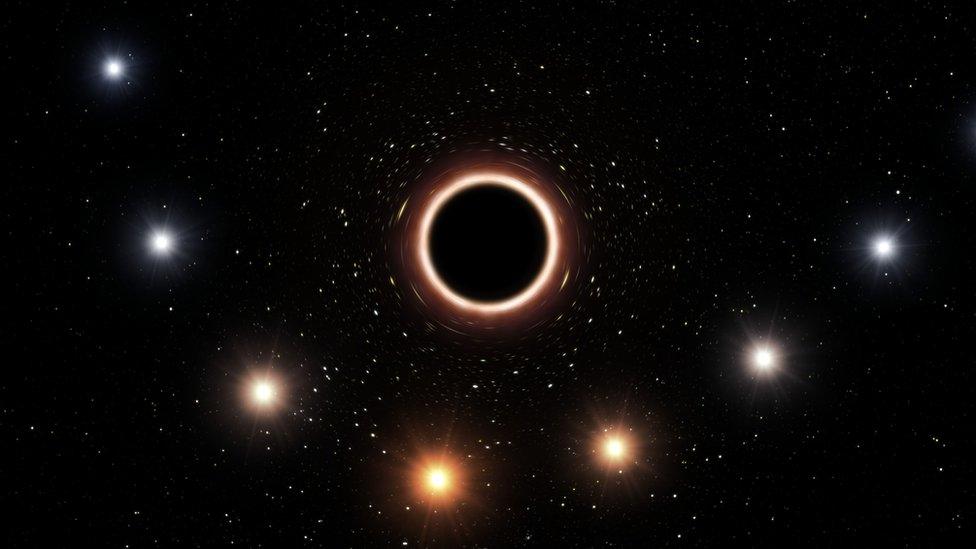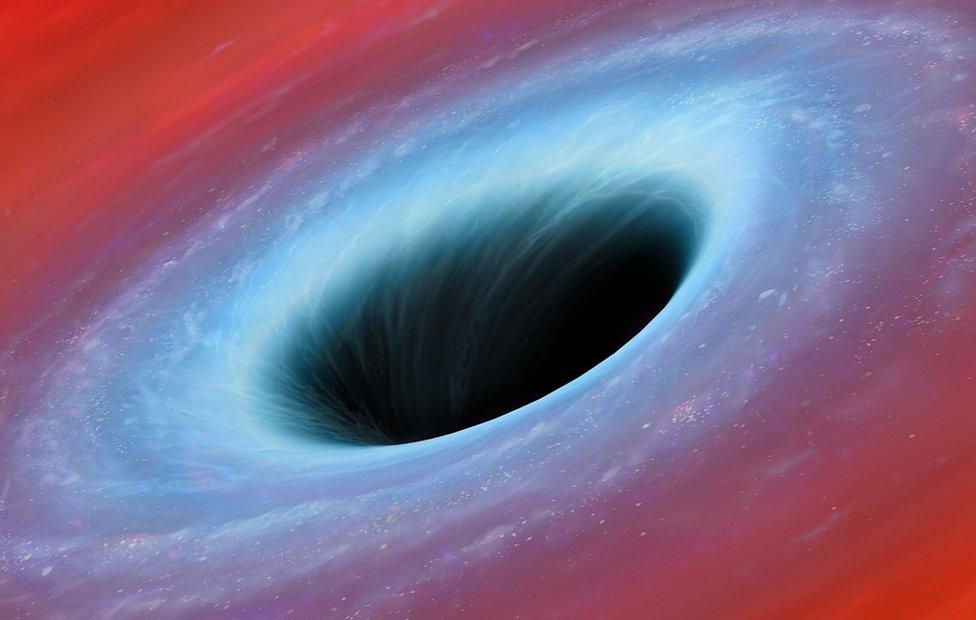Einstein theory passes black hole test
- Published

Astronomers got the result by tracking the movement of a star as it passed through the gravitational field of a black hole
The black hole at the centre of our galaxy has helped astronomers confirm a key prediction of Albert Einstein's ideas.
By observing a cluster of stars near the hole, they were able to confirm a phenomenon known as "gravitational redshift".
It's when the wavelength of light gets stretched out in response to a gravitational field.
The result , externalwill help scientists better understand the physics of black holes.
The Very Large Telescope (VLT), external in Chile found evidence for Einstein's prediction by observing a star, called S2, that passed through the intense gravitational field of Sagittarius A* - the huge black hole at the heart of the Milky Way.
The effect they observed, gravitational redshift, occurs as particles of light (photons) climb out of a gravitational well like a black hole. As they do, the light's wavelength gets drawn out.

Albert Einstein would no doubt be delighted
This shifts the wavelength to the red part of the light spectrum - hence "redshift".
It's predicted by Einstein's theory of general relativity, but has never been observed in an intense gravitational field such as that of a black hole.
Frank Eisenhauer, from the Max Planck Institute for Extraterrestrial Physics (MPE), external in Garching, Germany, said the measurement opened the door to more studies of the physics of black holes.
In future, he said, "we will see many more effects of general relativity in the galactic centre black hole. We will see the orbits of the stars change, we will see light go in circles, we will even see space-time rotate together with the black hole."
Dozen black holes at galactic centre
Black hole blasts out 'double burp'
Reinhard Genzel, also from MPE, said: "There is still more work to do to really come as close as you can to the event horizon [the "point of no return" of the black hole] where you might expect strong deviations from Einstein's theory."
Françoise Delplancke, from the European Southern Observatory (Eso), external, which operates the VLT, said that the laws of physics could only be tested here in the Solar System under particular circumstances.
"So it's very important in astronomy to also check that those laws are still valid where the gravitational fields are very much stronger," she explained.

The observations were carried out with the Very Large Telescope in Chile
S2 is one member of a star cluster that surrounds Sagittarius A*. These stars reach mind-boggling speeds when they approach the black hole - S2 comes very close to Sagittarius A* every 16 years.
Astronomers followed S2 before and after it passed close to the black hole on 19 May 2018, tracking its progress hour-by-hour.
When S2 passed by the black hole at a distance just 120 times that of the Earth from the Sun, it reached an astonishing orbital velocity of 8,000 km/s. That corresponds to about 2.7% of the speed of light.
The astronomers found that light from the star was indeed stretched to longer wavelengths by the very strong gravitational field of Sagittarius A*.
The results were perfectly in line with the theory of general relativity - and not explained by Sir Isaac Newton's ideas - which exclude such a shift.
"In sport, you would say it was 1-0 for Einstein," said Frank Eisenhauer.

Artwork: Astronomers want to test other aspects of physics around black holes
Odele Straub, from the Paris Observatory, in France, external, said: "What we hope is at some point we will see something in the galactic centre that we can't explain with Einstein's theory - that would be really, really exciting. Because then we could go back to the drawing board and come up with something better."
The astronomers are continuing to observe S2; observations of its trajectory should yield new findings about the extreme conditions around the Milky Way's central black hole.
Gravitational redshift occurs because, in order to escape a gravitational well such as a black hole, particles of light (photons) must expend energy.
However, at the same time, these photons must travel at a constant speed - the speed of light.
Therefore, the photons can't lose energy by slowing down, but must expend it in another way. This lost energy manifests itself as a shift towards the red end of the light spectrum.
The results are published in the journal Astronomy & Astrophysics., external
Follow Paul on Twitter., external